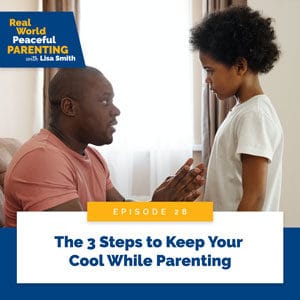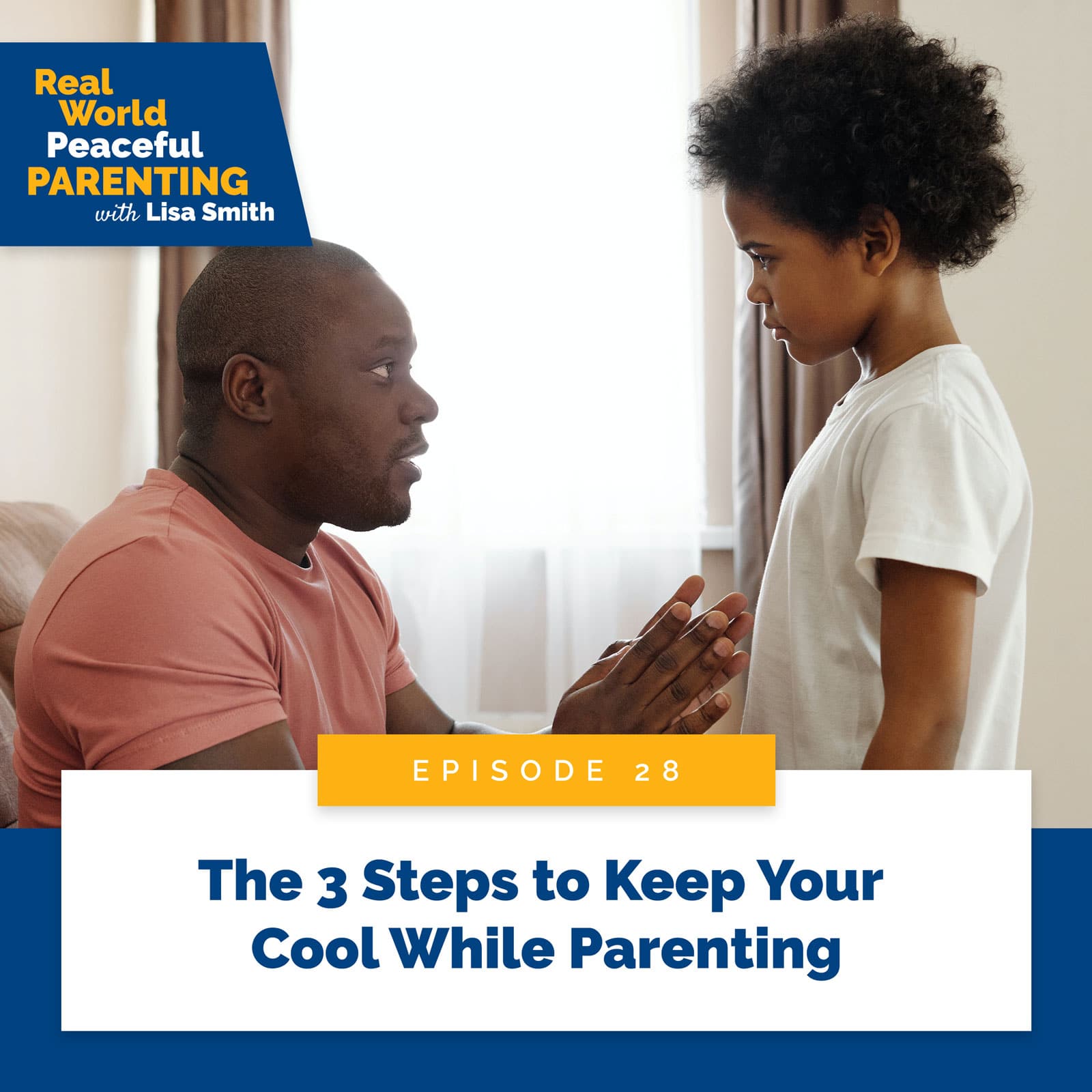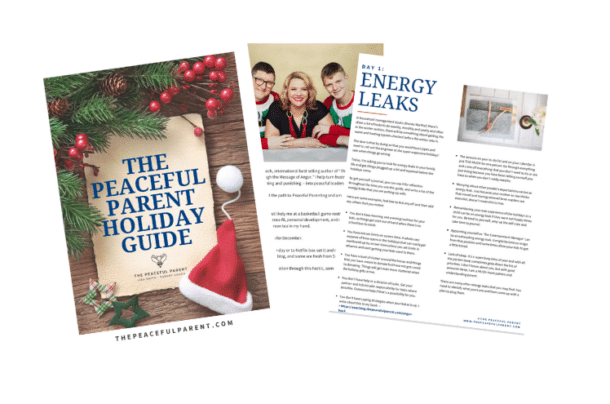
Let’s keep it real – we all get triggered at times by our kids. We experience big, angry emotions that result in us losing our cool and creating more drama for ourselves. You might try to stuff them down or make them go away, or even pretend they don’t exist, but this doesn’t help on your peaceful parenting journey.
Being a peaceful parent doesn’t mean that you don’t experience strong emotions like anger, frustration, resentment, or fear. Instead, a peaceful parent takes ownership of their feelings and works hard not to displace or project them onto their child.
In this episode, I’m sharing the magic with you and giving you my go-to repeatable process to help you stop reacting negatively to your kids’ behavior or storming. Nobody gets it right all the time, but these 3 steps I’m sharing with you will help you keep your cool while parenting and make your parenting experience a whole lot easier.
If you’re enjoying the podcast, click here to sign up for my free Peaceful Parenting mini-course! You’ll find everything you need to continue on the path to peaceful parenting over there just waiting for you. I can’t wait to see you there!
What You’ll Learn from this Episode:
- What it looks like to displace or project your emotions onto your child.
- The value of pausing when experiencing big emotions.
- Why it is impossible to regulate your emotions if you don’t pause.
- How to tell if you are parenting out of fear or anger.
- The benefits of regulating your emotions.
- Why you always have a choice to regulate.
Listen to the Full Episode:
Featured on the Show:
- Sign up for Peace & Quiet: A Crash Course For Parenting Your Strong-Willed Kids here.
- Click here to sign up for my free Peaceful Parenting mini-course! You’ll find everything you need to continue on the path to peaceful parenting over there just waiting for you.
- If you have a suggestion for a future episode or a question you’d like me to answer on the show, email us or message us on Instagram!
- Join my membership The Hive!
Get Your Peaceful Parent Summer Guide Now!
The guide is designed to offer tips, ideas and support to help you stay grounded and peaceful during this summer season.
Full Episode Transcript:
Welcome to Real World Peaceful Parenting, a podcast for parents that are tired of yelling, threatening, and punishing their kids. Join mom and master certified parent coach Lisa Smith as she gives you actionable step-by-step strategies that’ll help you transform your household from chaos to cooperation. Let’s dive in.
Welcome, welcome, welcome to today’s episode. I know I say this every week, but it’s so true. I am so excited that you are here. I want to begin today’s episode with a question. So here it goes. What does it mean to be a peaceful parent? Think about this for a minute.
Today I want to share with you what I think is at the heart of peaceful parenting, the backbone or the foundation of peaceful parenting. Today’s episode has the power to permanently change your parenting for the better and bring you the connection you want with your kids while gaining maximum cooperation from them. Yes, I said that, and I mean it. This episode promises to be a total game changer. So let’s dig in.
Let me ask you that question again. What does it mean to be a peaceful parent? I was asked this recently in an interview, and the answer I gave was too good not to share. In my opinion, a peaceful parent is not one who doesn’t experience strong emotions, strong feelings like anger, frustration, or fear. A peaceful parent is, however, a parent who takes ownership of their feelings and works hard to not displace these negative feelings onto their child.
Now let’s keep it real for a moment. We all get triggered, all of us, at times by our child’s behavior. We experienced big emotions. Anger, fear, frustration, shame, disappointment, resentment. We experience them. I want you to know that being a peaceful parent doesn’t mean we don’t experience the feelings. You are not a peaceful parent if you push your feelings down or pretend they don’t exist. Peaceful parenting is having a go to repeatable process to regulate ourselves instead of reacting negatively to our kids.
Today I’m going to share with you the process, the tool, the magic I use to do what I call zag rather than zig. All right? So step one, a real world peaceful parent is one who takes ownership of their feelings rather than displacing them or projecting them onto their kids. Displacing or projecting our feelings onto our kids looks like losing our shiz, storming on them, name calling, yelling at them, threatening them, punishing them. That’s what it looks like when we displace or project onto our kids.
Step one in not losing your cool is taking ownership of your feelings, recognizing them rather than displacing them onto your kids. Once you recognize them then step two is to take a pause. Oh it’s just the pause alone is a game changer. Take a pause, pause, pause. The value of the pause is it puts you at a fork in the road. It gives you options and choices. It slows your brain down. It lets you explore responses, and it keeps you regulated by keeping you out of fight or flight.
So step one is recognize the feelings. Step two is pause. Step three that can only come after the pause is to take a moment to regulate yourself instead of reacting negatively to your kids. The pause is the prerequisite to staying regulated. That’s it. That’s the magic.
Peaceful parenting is using the repeatable process of recognize, pause, and regulate instead of reacting negatively to our kid’s behaviors, our kid’s word, our kid’s storming. What I want you to know is the sweet spot in all of this is the pause. The pause allows you to take a moment to regulate. The more you work at the pause, the easier it is to regulate. It’s impossible to regulate without the pause.
When you recognize, pause, and regulate, you can’t displace your feelings onto your kids at the same time. The recognition starts the process, and the pause brings you to the fork in the road. The pause is the magic. It allows you to slow down, collect yourself, notice your thoughts, connect with your feelings. Decide whether you’re going to displace onto your kids or regulate.
I call this zig or zag. Are you doing to zig and displace or zag and regulate? You won’t always regulate. No one gets it right all the time. No one zags all the time, but the power of the pause is that it gives you options. It brings you to the fork in the road.
Right now you might have been reacting and displacing for so long, your brain might not even know there’s a fork in the road. You might have been zigging for so long that your brain just goes on autopilot, or your habit brain kids in. I’ve been doing this long enough—recognize, pause, and regulate—that when I am storming, when I am reacting negatively today to my son’s behavior, I know what I’m doing. I’m at the pause. For some reason, I’m choosing not to regulate.
Sometimes it’s because fear is coming up for me. I’m parenting out of fear. This happened just yesterday. Yesterday I was triggered by something my son did. I was flooded with the emotion of anger. I recognized the anger, and I felt the pause. If I’m totally transparent with you all, I can tell you that I chose not to pause. I was like, “Yeah, we’re not self-regulating right now.” My brain said I’m justified because I’m so scared, but I was at the pause at the fork in the road.
Now this morning my brain tried to do it again. My brain tried to go straight to dysregulation and projecting onto my son. But because I was at the fork in the road and I had a choice, today I was like, “Yeah, we’re not going to do that today because it doesn’t work. He doesn’t react the way I want him to. My storming always leads to an explosion in our house.” So today I recognized, and I paused and then I regulated instead of reacting negatively to his behavior.
Because what I know is that when I react negatively by storming, when there’s a storming parent and a storming kid, there’s going to be an explosion 100% of the time. It’s like storming on steroids. What I also know is when I model reacting, I’m teaching him to be reactive himself, which is exactly what I don’t want to do, right? This is the motivation to learn, recognize, pause, and regulate. Then we’re also modeling that for our kids, and they learn not to displace their feelings onto other people.
Said another way. As we recognize, pause, and regulate over and over and over again, our kids learn constructive ways to self-regulate because they see you doing it real time. They see you pause and regulate when you show big emotions.
Now maybe you’re thinking, “Hey Lisa, this sounds great. I like the idea, but I don’t know how to do it.” Okay. Let’s talk through the steps. There’s three steps. I love these. Step one is to recognize, which means to notice and acknowledge the big emotions that are coming up for you. Don’t try to stuff them down. Don’t try to make them go away. Don’t try to be a martyr. Step one, recognize.
Step two, take a pause. The pause is the magic. It’s the tool. It’s the secret weapon to not lose your shiz. The pause brings you to the fork in the road and gives you options. Then step three is that the pause will naturally lead you to take a moment to regulate instead of reacting negatively to your kid’s behavior.
Let me share a couple of examples with you. Recently my client Susan said, “My son was fighting with me this morning because he didn’t want me to comb his hair before school. We were running late, and he said he didn’t want his hair sprayed with the bottle because it scared him. As he was fighting me and wiggling around and yelling, I started to feel myself get really angry with him.
“In the past I would have just sprayed his hair with the spray bottle and continued on combing it while he was screaming at me. Today I recognized that I was getting angry because it wasn’t going as I thought it should. So I recognized and I paused. The pause gave me a moment to regulate myself rather than displace my emotions on him and become dysregulated. The pause allowed me to regulate and ask him why he was scared. I genuinely asked it from a place of curiosity rather than anger.
“He said, ‘Mommy, I don’t like it. I’m scared of the water bottle. I don’t like the spray in my face.’ I had no idea all the other times he was screaming and melting down, it was because he didn’t like the water in his face. Wow. I told him I hear you. How about I spray the water in my hand and run it through your hair? It was that simple. That only happened, Lisa, because I recognized, paused, and regulated myself. The pause is magic.”
Here’s another example. Another client, Stephanie, said, “Lisa, tonight we practiced the pause. At bath time my kid was up to some shenanigans and wasn’t moving along to get in the bathtub. I could feel myself starting to get really angry, and I was on the verge of exploding. Then I remembered the pause. I took a deep breath, and I just kept saying to myself ‘pause, Mama, pause’. That allows me to regulate myself and give him a couple of choices.
“So I gave him his choices and I walked out of the room. What I realized as I was leaving the room is that my four year old son thinks better while I’m not on top of him. Sure enough a couple minutes later he came running down the hallway telling me, ‘Mommy, mommy. I’m ready to get in the bathtub.’ Wow, the pause worked.”
Now you may not always choose to regulate. Nobody gets it right all the time. Nobody. I don’t care if your Mr. Rogers, Deepak Chopra, Eckhart Tolle, Oprah Winfrey, or Brené Brown or Lisa Smith as I’ve shared with you. I don’t care who you are. The wisest of the wise sometimes choose to react negatively instead of regulate.
What I want you to hear is that you have a choice. You can zig or zag. You may not have realized that until today. You may not have realized that there’s a fork in the road, but I want you to know that it’s possible for you, yes you. You. No, I’m talking to you. I promise you there is a fork in the road. I don’t care how you’ve parented in the past, how old your kids are, how much damage you think you’ve done. What I want you to hear is that you have a choice. You can zig or zag. I want you to zag as much as possible. All it takes is to recognize, pause, and regulate instead of reacting negatively to your kid’s behavior.
By the way, these steps—recognize, pause, and regulate—are also incredibly useful in partnerships and marriages and romantic relationships. The three steps are useful with mother-in-laws and bosses and coworkers and difficult neighbors and coparents you like and coparents you don’t like. Recognize, pause and regulate.
So let’s recap. A peaceful parent doesn’t mean we don’t experience big emotions. Peaceful parenting is understanding the three steps to keeping your cool. Recognize, pause, then regulate. RPR. Using the pause and then taking the time to regulate ourselves instead of reacting negatively to our kids. That’s the secret sauce right there.
Kids are going to storm, melt down, get sassy, do something wrong, make a mistake, not do as asked. What I want you to take away from today’s episode is instead of displacing our emotions onto our kids and then dysregulating ourselves into storming, pause and regulate.
Now if you’ve been stuck in an old pattern for a while, it’s going to take some time to practice this. To get good at it. To reprogram your habit, Brian. Be patient. Don’t give us. Set your intention. Remind yourself you have a choice. Talk to your brain and explain, I can go the old way, which is to zig, react and displace, or I can go to the new way, which is to zag. Which is to recognize, pause, and regulate.
Then what I want you to do is practice, practice, practice. Listen to this episode multiple times. Understand the steps and practice, practice, practice. You’ve got this. I know it. I want to leave you with a saying that I really love from Angry Smithson. He says, “The sign of a good parent isn’t the child’s behavior, but the sign of a good parent is the parent’s behavior.” That comes from recognize, pause and regulate. You’ve got this. I know it. Until we meet again, I’m wishing you peaceful parenting by using recognize, pause, and regulate.
Thank you so much for listening today. I want to personally invite you to head over to thepeacefulparent.com/welcome and sign up for my free peaceful parenting minicourse. You’ll find everything you need to get started on the path to peaceful parenting just waiting for you over there at www.thepeacefulparent.com/welcome. I can’t wait for you to get started.
Visit www.thepeacefulparent.com/podcastlaunch to learn more about the contest and how to enter. That’s www.thepeacefulparent.com/podcastlaunch. I’ll be announcing the winners on the show in an upcoming episode. So stay tuned.
Thanks for listening to Real World Peaceful Parenting. If you want more info on how you can transform your parenting, visit thepeacefulparent.com. See you soon.
Enjoy the Show?
-
-
- Don’t miss an episode, follow the podcast on Spotify, Apple Podcasts, Stitcher, or RSS.
- Leave me a review in Apple Podcasts.
-






